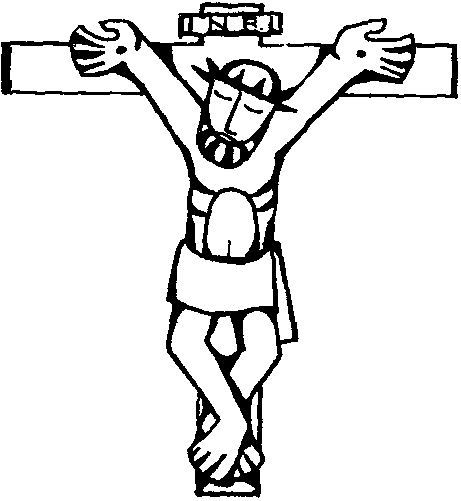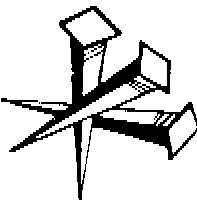The Crucifixion
Mark 15:21-47
| Read the passage in your Bibles | |
| Read the Notes on this Sheet | |
| Answer the Questions which follow |
Notes
Mark’s Account
Mark gives the essential details in his account of the crucifixion in a simple form. The other gospels fill in much more detail which you may be familiar with. Don’t think that Mark’s Gospel includes something which it doesn’t. In particular, Mark does not mention the conversations which Jesus had with his Mother and John (that’s in John) or with the two thieves (Luke).
Timetable
Jesus was crucified ‘at the third hour’, which is 9am. (verse 25) From the sixth to the ninth hour Mark says there is darkness over the land (v33). Jesus died at the ninth hour (about 3pm).
Crucifixion
Crucifixion was not an unusual punishment. It was the way Romans usually executed those who rebelled against their rule. One attraction of this form of punishment was that the condemned was on display as a warning to others. We now know that the prisoner carried only the cross-beam to the place of execution, and nails were driven through the wrist (not the palm of the hands) and the feet. Death was slow - sometimes several days, and was usually caused by suffocation, as the condemned became unable to support his body in order to breathe. Mark’s readers would have known what crucifixion was, so Mark does not give any description at all. (v24).
Details
Simon of Cyrene, who was an African, is made to carry the beam of the cross. Mark mentions his sons, which probably means that his sons became Christians and that Mark’s readers knew them.
Golgotha means ‘skull’ in Aramaic. From the Latin word for skull comes the English word Calvary. We don’t know for sure where the site was: the name may come from a hill which looks like a skull, or from its use as a place of crucifixion.

They offer Jesus a simple anaesthetic in the form of wine drugged with myrrh. He refuses it.
The soldiers who crucified Jesus were entitled to his clothes, so they played dice for them. Mark reveals them to be quite unconcerned about the one dying above them.
The charge against Jesus is placed at the top of the cross: ‘King of the Jews’. The Romans probably intended this as a warning to any Jewish rebels. Of course, Jesus never claimed to be a king of that kind. (Note: in Saint John’s Gospel it says that the notice read ‘Jesus of Nazareth, King of the Jews’. The first letters of this in Latin are I.N.R.I. which you often see on crucifixes).
Two robbers are crucified with Jesus. The word used could mean that they are Zealots, rebels against Roman rule.
Jesus is mocked by passers by, teachers of the law and even those crucified with him (Mark does not mention a good thief crucified with Jesus). They want to see Jesus perform a miracle. Perhaps Mark is making the point (again) that Jesus is a different kind of Messiah: his death on the cross is part of his Messiahship.
At noon darkness fell over the land (v33). Mark gives no explanation for this. It probably represents God’s disapproval. In the Old Testament, darkness of the sky is often a sign of judgement. Some explanations suggest this was an eclipse, but it could just as well have been cause by poor weather conditions.
Jesus makes a cry of despair (sometimes called a ‘Cry of Dereliction’). This is the first line of Psalm 22, which begins with despair but ends with hope. We can only guess what Mark thought Jesus meant by these words. Even onlookers misunderstood them, thinking Jesus was calling for Elijah.
The curtain of the temple split in two at Jesus’ death. The curtain separated the Holy of Holies, where God’s presence was thought to be, from the rest of the temple. This may symbolise the end of the Jewish temple as the true place of worship (the temple was destroyed in AD 70). It may be a sign of God’s disapproval (just as the High Priest tore his robes at Jesus’ ‘blasphemy’).
It is the Centurion who says that Jesus is the Son of God: Mark has a Gentile expressing faith in Jesus, immediately after the temple curtain rips. Mark’s account is making it clear that Jesus’ death means that God’s salvation is for everyone, not just the Jews.
It is the women who are there to see what happened. The male disciples have fled. (Mark does not mention John being at the cross.)

The Burial
The Romans respected Jewish burial customs (at least in this instance) and let Jesus be taken from the cross. Pilate is surprised that Jesus had died so quickly. Because it is Preparation Day (Friday), and the Passover, they had to move Jesus’ body quickly. (Remember, the Jewish day begins at sunset.) It is a member of the Sanhedrin, Joseph of Arimathea who gives a tomb, and the women seb e where Jesus is buried.

Good Friday
The Church remembers these events on Good Friday, in particular in the Liturgy which is usually celebrated on the afternoon of Good Friday, between 2pm and 3pm. The Liturgy includes the reading of the Passion according to John, and an act of Veneration of the Cross. Catholics also remember the Crucifixion in the Stations of the Cross and in the saying of the Rosary.
Why ‘Good’ Friday? The name was probably originally ‘God’s Friday’. However, Christians also believe that this is the day when the Father’s showed love for humanity most fully by allowing the death of his Son. In this sense, it is ‘good’.
Questions
Knowledge
Copy out these questions, and answer them in your files. The questions test your knowledge of the passage. You need give only short answers.
Understanding
These questions refer to the passage and the Notes.
Evaluation Activities
These questions ask for your own opinions or feelings on the passage.
Use your imagination
Write a letter or diary entry of one of these, describing the events of the crucifixion.
or
What do you think?
The following questions require quite detailed answers. It is better to answer one fully, than to answer all of them superficially.
- For Catholics, a crucifix is one of the most important symbols of their faith, yet the very first Christians never used the crucifix as a symbol. Why do you think this change has taken place? Do you think the early Christians had a better idea?
- Christians understand Jesus to be God the Son. Do you think that the idea of a God who suffers is a helpful one? Give reasons for your answer.
- When Jesus died and was buried, the only ones of his followers who were present (according to Mark) were women. Why do you think this was? Does this have any meaning for us today?
![]()